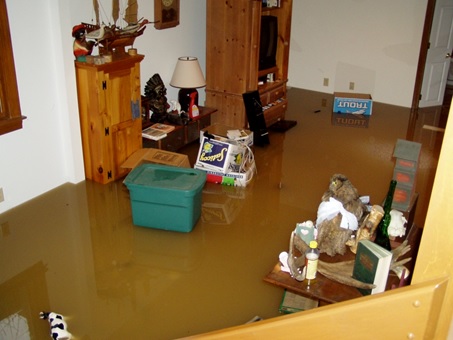A wet basement is more than a nuisance; it can be a disaster waiting to get worse. It’s very important to get it dried out quickly so that other components of your home don’t become affected. In a report from the American Society of Home Inspectors (ASHI), they reported that 60 percent of homes have experienced, or will experience a wet basement. Basements are for the most part, dark areas where the lack of bright sunlight and tendencies toward higher humidity, are places where mold is likely to grow. And although mold growth may be the largest danger, it is far from the only one.

How the Water Enters a Basement
Almost every basement is below grade and there are several ways for water or moisture to enter a basement. As we say in the water damage restoration industry, “Water will always flow from wet to dry, if it can.” Below are some of the ways water can “flow” into a basement:
Floor Cracks: water creates hydrostatic pressure as it builds up under a concrete floor. Hydrostatic pressure is defined as the pressure exerted by a fluid (in this case water) at rest with respect to adjacent bodies. This means as water builds up under the concrete slab, it is easier for it to force its way upward through a small crack in the floor than it is to move downward into the ground.
Window Wells: the purpose of window wells is to keep soil and water away from basement windows. Every window well should have a drainage pipe installed in it to move any water that enters it down and away from the basement. As this drainage pipe gets clogged by dirt and debris, instead of flowing away, the water will force (hydrostatic pressure again) its way around the window edges and enter the basement.
Wall Cracks: wall cracks are a result of the expansion and contraction of the earth around the basement. This soil movement is caused by moisture and freezing and thawing action. As the ground around the basement moves, cracks can occur in the basement walls. When there is a crack, water will force itself through the crack and into the basement. Water always takes the path of least resistance, which in this case will be through a crack rather than through compacted soil.
Floor Drains: some type of clog is usually the cause of this problem; trees roots, leaves, grease, and solid objects like toys flushed down a toilet can cause a drain not to function as it should. Water entering the drain system will have nowhere to go and instead, back up and flow out of the lowest drain, either located on the floor, a sink, or even a toilet. Not all drain clogs are caused by objects or debris. Sometimes a drain line can be crushed, or just deteriorate and collapse due to age.
Sump Pumps: this is a biggie! A sump pumps job is to remove any water collected by the basement’s outside and inside drainage system. Rainwater will eventually work its way down through the ground and collect at the base of the basement’s footers. The water is then collected by the footer drains and fed into a pit in the basement containing a sump pump. When the water reaches a predetermined depth in the pit, the sump pump turns on and pumps the water safely away from the basement. If this pump fails during or just after a rainstorm, water will quickly flow out of the pit and flood the basement. It takes very little time for the water to become several inches deep throughout the basement.
Drying Out a Basement
Before taking any steps to dry out a basement, you must determine why the water has entered and rectify that cause. To do otherwise is like trying to bail water with a window screen. You may get some water out but more of it will continue to flow in.
After you have stopped the inflow of water, the next step is to physically remove as much water as possible. This can be achieved by using a combination of pumps, vacuums, and other extraction devices. It is 500 times easier to physically remove water than it is to evaporate it.
After the extraction of as much water as possible, it’s time to use evaporation. This should be done with commercial-grade dehumidifiers and fans (high-capacity air movers). At this time all windows and doors into the basement should remained closed as much as possible to allow the equipment to do its job. The evaporation stage is not something that can be accomplished overnight and anyone who tells you otherwise is making promises that they can’t keep. It usually takes 48 to 72 hours at a minimum to complete this process. Proper evaporation can only be accomplished through control of temperature and rapid air movement.
Wet Basements Are NOT the End of the World
Flooding is the number one natural disaster in the United States. Don’t panic if you find water in your basement. Panic only leads to more misery and possibly bodily injury. Never enter a flooded basement when the electricity is still turned on. The dangers of electric shock exist, as well as the possibility of slip and fall accidents.
Once you have determined that it is safe to enter, save what you can by moving personal items to a drier location. There is no need to remove furniture, simply block the furniture up out of the water. Once you reach the evaporation stage of drying out the basement, the furniture will be able to dry as the evaporation occurs.
At a 3-day training class for water damage restoration, I witnessed a sofa being saturated on purpose with a garden hose. The sofa was placed on Styrofoam blocks and left in the room to dry along with the carpeting and walls. NO EXTRACTION WAS DONE TO THE SOFA. Three days later, when the drying was complete, the sofa was also completely dry. You could kneel on the sofa cushions and not get your pants wet. Needless to say, it was an amazing learning experience and speaks of the power of professional drying capabilities!
If you find that your basement has flooded, you should contact Water Mold Fire Restoration at 800-905-0277. We have certified water damage experts that can answer any questions you may have concerning how you should proceed. Our emergency teams are standing by, ready to assist you 24 hours a day. We will even respond on holidays. Our initial inspection and consultation are free with no obligation. If you would rather contact us by email, do so at help@watermoldfire.net.








